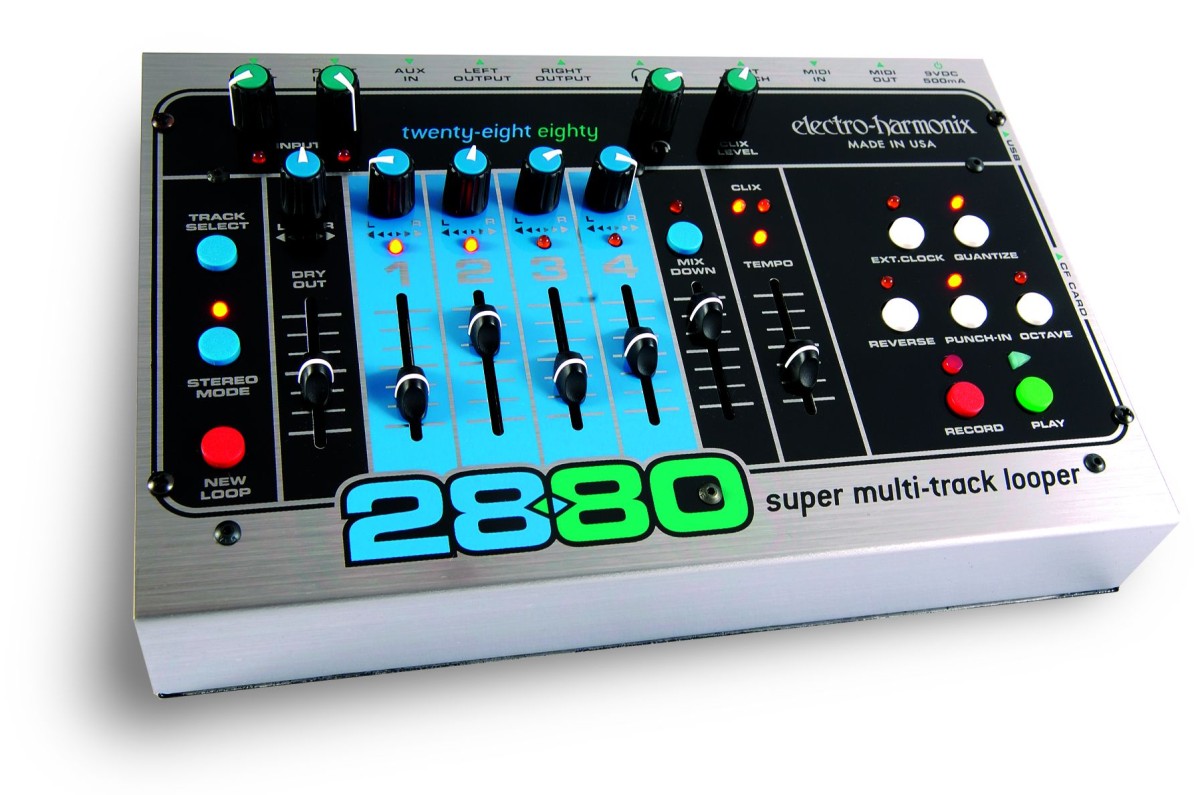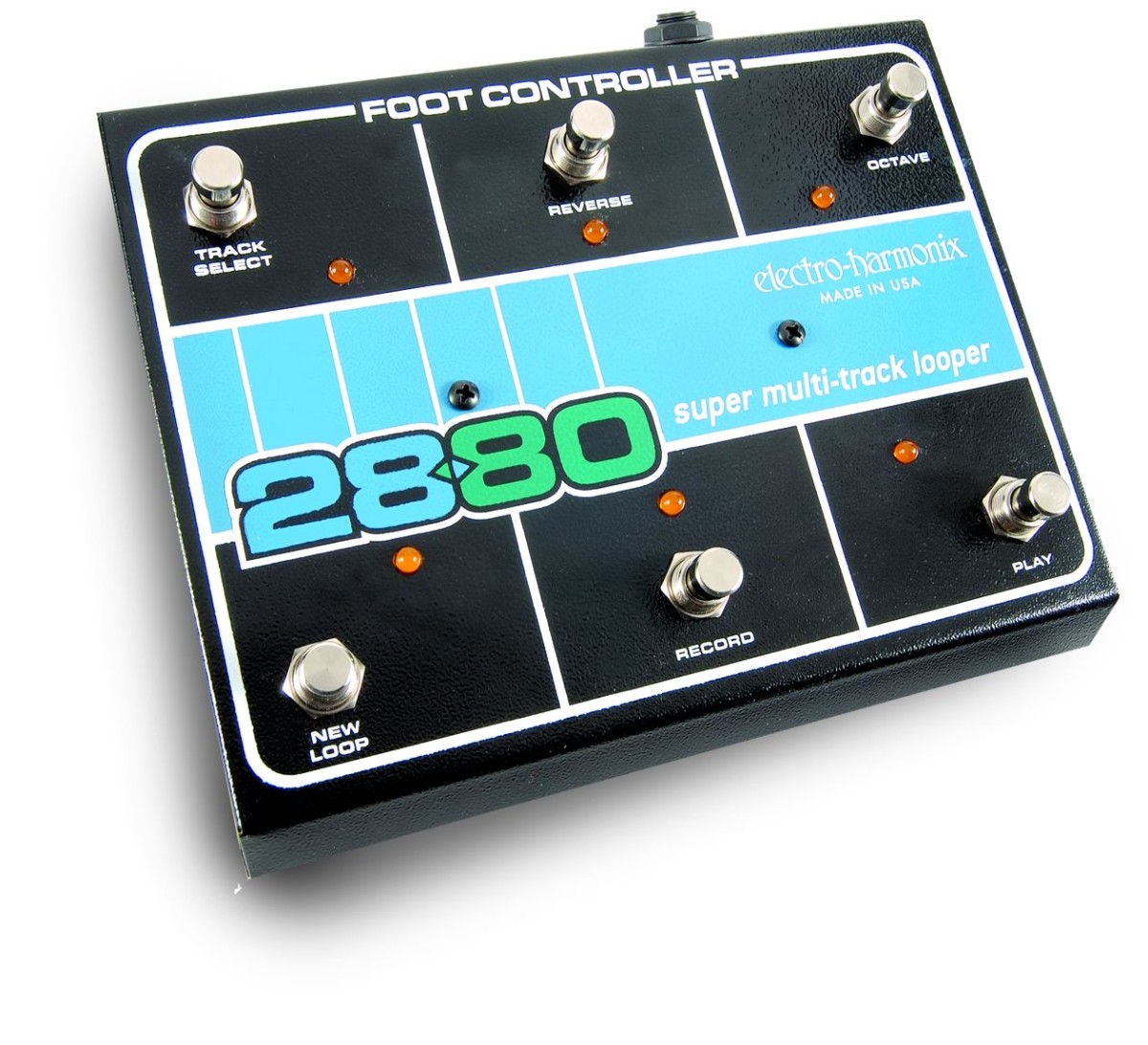MusicRadar Verdict
A heavyweight looping machine with hefty overdubbing, USB/ flashcard storage and recall.
Pros
- +
Great sound quality, doesn't degrade. Versatile, for guitarists or DJs. Can work with DAWs.
Cons
- -
Tempo and pitch are linked.
MusicRadar's got your back


E-H make some kick-ass pedals - most of which are analogue and owe much to their powers of distortion. This one, however, is as clean as a whistle and has a pile of digitalia within, all bent to the task of creating a dedicated looping machine.
Not a delay machine that also loops, you'll notice - just a looper. A looper with so much memory (Flash Card permitting) that you could record a whole song's worth of multi-track on it in CD quality stereo sound.
In creating this beast, a significant evolution from the recently re-released 16 Second Delay (originally from 1983), E-H have solved a lot of the inherent niggles that looping delays always had, and also created a groovy sound mangler, from which some very strange and wonderful sounds can be extruded. Better than jamming with the only other musician in the world that completely understands them - namely: themselves. Or even better, a whole bunch of themselveses.
The 2880 is not designed to sit on the beer sodden stage and be operated by your foot. It is the brain, and is all about fingers and sports eleven neat little buttons along with seven sliders and nine little pots. It looks funky, feels solid and the layout seems self-explanatory, so in the long-standing musician's tradition of wasting time and developing bad habits, we decided to ignore the manual and pile straight in too suss it out 'intuitively'.
In use
Within a couple of minutes we had a rocking loop of about ten guitarists going - some going backwards and some playing at double speed! Great fun. A stompbox remote controller is also available, and connects to the brain using a standard 1/4" jack lead. Using the feet to start, stop and otherwise control the 2880 makes for a far more seamless investigation of it's surprising depths, and is also essential for the whole 'be your own band' bit.
The 2880 has four 'tracks' upon which to lay your loops. Each of these tracks has a volume slider and a pan pot. Next to these first four tracks is a fifth mixdown track to which you can mix down the contents of the first four tracks - complete with volume and pan changes. Here's how you do a basic loop, assuming the 2880 is occupying a position between your guitar and amplifier and the input levels are set nicely.
You turn the 'dry out' fader up so you can hear yourself, hit record and start playing. When you get to the end of what will be your loop you either hit record and the machine stops, or you hit play, the machine returns to the beginning and starts recording straight away on track 2. After doing something else on track 2 you could stop, adjust the volumes of your two parts on tracks 1 and 2, then select track 3 hit record and so on until you have four parts. These parts can then be bounced down to the mixdown, making a stereo mix of all four tracks whose level is controlled by the mixdown fader. This is the basic operation of the 2880 - but there's a lot more.
You can also overdub back onto track 1 if you like. What you previously recorded will not go away - you simply add another sound on top of it. If you leave the loop going you can continue adding sound on top of it as long as you like. The previous sounds will not degrade, you simply pile them up. This represents the maximum capability of some looper pedals, but with the 2880 you can repeat this infinite stacking on each of its four channels. Think about that.
Once you've mixed down, you can record a whole bunch of new stuff on tracks 1 to 4 that will play back alongside your mixdown. You can then do a new mixdown of everything you are hearing back on to the mixdown track. This is limitless overdubbing, people - with a good deal of mix flexibility built in.
Rather than list the additional functions, let's imagine a possible 2880 looper session using just one guitar.
We start by recording a great bassline on the lowest string of a normal electric guitar played at double the normal speed onto track 1 (listening to the onboard metronome for an easy life).
We then hit record to stop the 2880 and, because it is in quantize mode, it waits until the exact end of the nearest bar to stop, thus creating a perfect loop. We then re-arm track 1, start it recording and play the same thing again twice around the loop so we have a triple-tracked part. We hit the octave button and the part halves in speed and lowers an octave to become the fat bassline we originally intended. Then we overdub again onto track 1 with the bottom string of the guitar to add an octave-up version of the bassline.
Then we move to track 2 and record some funky rhythm chords. Unfortunately there was a fluff in an otherwise perfect take, and because our loop is nearly a minute long we don't want to play it all again, so we hit the punch-in button, hit play and then hit record when we need to drop in and fix the mistake. Hitting record again drops us out and the mistake is fixed.
Moving to track 3 and we play a juicy melody, to which we then add three-part harmony at slightly lower volumes. It's getting a bit late now, so we're working from the headphone socket.
For a bit of a special effect we press the reverse button, arm track 4 and record two or three chords along with the backwards version of our masterpiece. Then we hit the reverse button again and listen back enjoying the sound of the occasional reverse chords throughout.
Then we bounce it all down to the mixdown track, freeing up tracks 1 to 4 for skanks, harmonics, palm-muted chugs and so on and so forth. Eventually there's nothing else to record, so we plug in our USB cable and drag the new loop info from the 2880 to our desktop folder of loop projects, and load up a session from last week and have a look at that.
Then we head off to a gig with all that night's loops stored on their own flash memory cards - some of which are actually full stereo CD quality backing tracks. Well, it saves lugging a computer around, which can't be a bad thing, eh?
Of course the 2880 can slot into lots of different places in your set-up. Even in a guitar set up it can be an effect loop on the amp, meaning that you can use different guitar sounds for each part you record.
And obviously the 2880 can just sit over the mix bus of your desk or outputs of your DAW, so any sound you're capable of making is fair game for a bit of looping. A great place for it would be right next to a pair of decks - it's ideal for knocking a quick break together and scratching up a storm.
Playing with the tempo control after the event is pretty fun too, the combination of that and the reverse button can create some pretty wild slices of sound. The mixdown track can be isolated from the tempo controller, so tracks 1 to 4 can actually be played back alongside the mixdown at a different pitch and tempo, creating some pretty wild and crazy phasing and flanging effects along the way.
All in all, the 2880 does all you've come to expect from a looper except frustrate the hell out of you. E-H have solved the problems of click tracks, automatically making neat loops, mixing parts after they're recorded, storage and recall, and they've even included MIDI Clock send and receive (with song position pointers and outgoing start and stop commands too), so you can incorporate the live looping thing into a backing track or click track scenario.
The controls are seamless, and the smoothness of the sound just as satisfying. One thing though - if they could only de-couple the tempo from the pitch... well, that would be perfect.
MusicRadar is the internet's most popular website for music-makers of all kinds, be they guitarists, drummers, keyboard players, DJs or producers.
GEAR: We help musicians find the best gear with top-ranking gear round-ups and high-quality, authoritative reviews by a wide team of highly experienced experts.
TIPS: We also provide tuition, from bite-sized tips to advanced work-outs and guidance from recognised musicians and stars.
STARS: We talk to artists and musicians about their creative processes, digging deep into the nuts and bolts of their gear and technique. We give fans an insight into the actual craft of music-making that no other music website can.
"There’s plenty for us guitarists to learn – and ‘less is more’ is the overriding lesson": how to play like George Harrison on The Beatles' Abbey Road
“They didn’t like Prince’s bikini underwear”: Prince’s support sets for the The Rolling Stones in 1981 are remembered as disastrous, but guitarist Dez Dickerson says that the the crowd reaction wasn’t as bad as people think
“We are so unencumbered and unbothered by these externally imposed rules or other people’s ideas for what music should be”: Blood Incantation on the making of Absolute Elsewhere and how “Data from Star Trek” saved the album – and the studio










